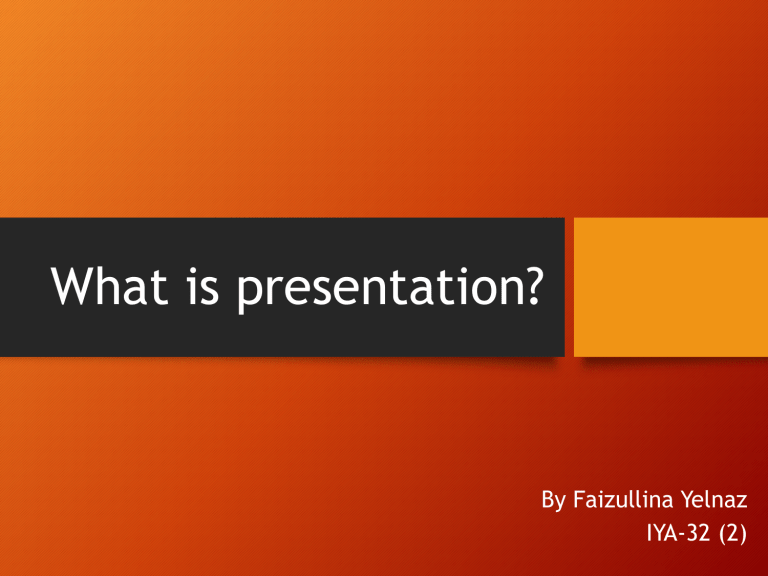
What is presentation? By Faizullina Yelnaz IYA-32 (2) WHAT IS PRESENTATION? • A presentation is an activity to express your ideas, a point of you in public or to an audience, or persuade the audience to take a certain decision. THE AIMS OF PRESENTATION • All presentations are aimed at either providing information or doing persuasion. HOW TO ORGANIZE IDEAS • Whenever you have determined a topic of presentation, you can organize the subtopics or your ideas in the following way. Having had an aim? If yes, structure your ideas and manage the time. Organizing ideas 1. Spider web (mind mapping) vocabulary by Heineich by Moon Teaching items definitions by Ytreberg structure Instructional Media for young learners visual types comprehension functions audio reinforcement audio visual internalization 2. TABLE Instructional Media for Young Learners Definitions - Oxford Dictionary - Reference book on presentation Functions Types Comprehension -Audio Reinforcement -Visual Internalization -Audio + visual Teaching Items -Vocabulary -Structure -Etc HOW TO CONTROL OURSELVES 1. Body Language a. b. c. d. Eye contact Hands Facial Expression Posture and Movement 2. Gestures a. b. c. d. Descriptive gesture Emphatic gestures Counting gestures Attitude gestures 3. Fears 4. Nerves Body Language Eye contact Hands Body Language Facial Expression Posture & Movement Gestures Descriptive gesture Emphatic gestures Gestures Counting gestures Attitude gestures Positive body language • Eye contact to keep audiences' attention (Asian audience might feel aggressed.) • Facial expressions should be natural and friendly. Don't forget to smile. • · raise eyebrows to show surprise • · open eyes wide • · squint your eyes • · knit your eyebrows to show consternation or puzzlement • Posture – stand straight but relaxed (do not slouch or lean) • Movement - to indicate a change of focus, keep the audience's attention • · move forward to emphasize • · move to one side to indicate a transition • Gesture • · up and down head motion or other movements to indicate importance • · pen or pointer to indicate a part, a place (on a transparency). • · shrug of the shoulders to indicate "I don't know!" • · hands - back and forth = two possibilities, more or less • · arm - movement back, forth Negative body language • loss of eye contact: looking at notes, looking at screen, at the board, at the floor • don't stare, or look blankly into people's eyes • • • • swaying back and forth like a pendulum back turned to the audience nervous ticks hands in pockets Fears QUESTIONS Am I making a fool of myself ? Is the presentation drying up? ANSWERS Admit the mistake and make a joke, then carry on the presentation. o Make use of notes which may help you find the place immediately. o Say the same thing in more than one way to clarify an idea. Does it reach the audience’s Check the audience and plan a expectations? good presentation. Nerves Make the audience less scary. Ask for a glass of water to relax the vocal cords. Rearrange the facilities / place you will use. Rehearse at home and in the actual venue. Take a deep breath before you start, and try to be relaxed. Check the facilities you will use, e.g. LCD, laptop, etc. Order the notes you will use. Don’t tap your fingers on the table or hold a pen and shake it gently. HOW TO CONTROL AUDIENCES 1.Audience arrival 2.Visual aids 3.Your voice 4.Language Audience arrival • When your audience arrives, try to do the following things: 1. 2. 3. greet and meet them before the presentation start; look for the audience needs; and introduce the participant to each other. Visual aids • In a presentation the use of the visual aids is of great assistance because they can attract the audience’s attention and help the content be understood easily. There are rules to follow if the visual aids are to be used, namely, they should: 1. Content simple and short messages 2. Be written clearly 3. Be relevant to the purpose in the presentation 4. Show contrasted color 5. Be written in a big letter. Your voice • Another aspect you have to think of whenever you speak in front of an audience is how to control your voice. Use high volume to provide emphasis of a particular point. Make use of pauses, pitch, repetition, and variety of voice. Also clear voice is recommended. Language • The best language to be used is simple and short. Use jargons to a particular audience only. Make use of anecdotes and analogies for variation and attractiveness.




